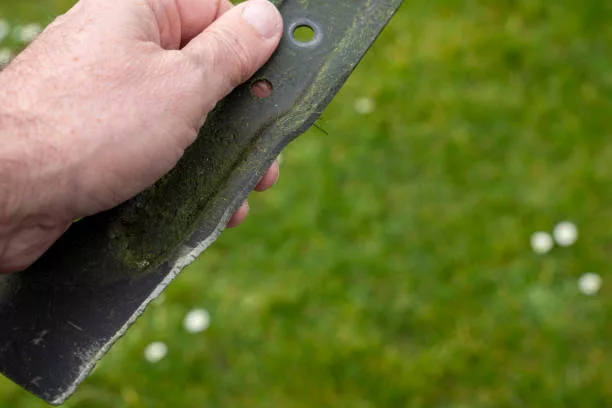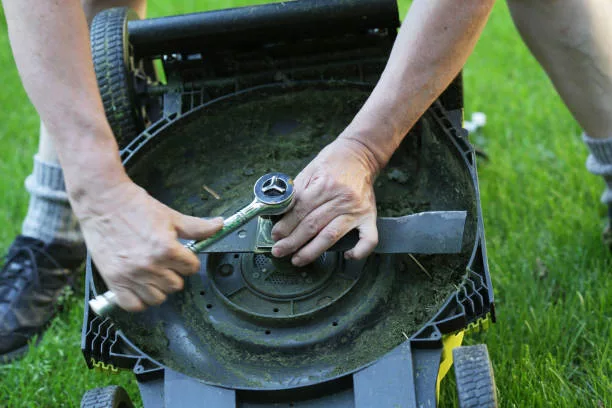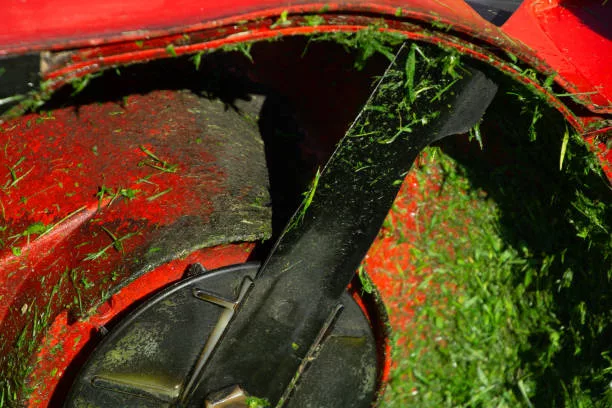Who said maintaining a perfect lawn was easy? We’ve all seen the struggle; it’s like trying to tame a rebellious teenager. The secret weapon in our lawn care arsenal? The humble lawnmower blade. Yeah, you heard me right. Let’s dive into the story of how we can turn our rebellious lawns into well-groomed verdant carpets.
When it comes to lawn care, we often think of watering, fertilizing, and mowing. We rarely ever give much thought to that piece of metal spinning under our mowers. But the lawnmower blade is the unsung hero of a manicured lawn.
What’s in a Blade?
The lawnmower blade, simply put, is the slicing magician of your mower. It’s a piece of hard metal, shaped and sharpened to perfection, designed to cut grass cleanly and efficiently. But do we ever stop to think about how this blade affects the overall health of our lawn? Maybe it’s high time we did.
Every grass blade cut by the lawnmower blade isn’t just an aesthetic task; it’s a mini-surgical operation. A sharp lawnmower blade cuts the grass cleanly, promoting healthier growth and a thicker lawn. On the other hand, a dull blade tears the grass, leaving it susceptible to diseases and pests.
The Anatomy of a Lawnmower Blade
If you think all lawnmower blades are created equal, think again. The design of a lawnmower blade plays a crucial role in how well it performs. Depending on the task at hand, you might need a different type of blade.
There are mainly three types of lawnmower blades: high-lift, low-lift, and mulching blades. High-lift blades are designed to cut grass and eject the clippings into a bag. Low-lift blades are perfect for areas with less dense grass, while mulching blades cut grass into tiny pieces that decompose to fertilize your lawn.
When Should I Replace My Lawnmower Blade?

Recognizing when to replace your lawnmower blade is just as important as knowing how to do it. The blade isn’t immortal; like any tool, it has a lifespan. Over time, the blade gets worn out, bent, and dull, all of which can affect its performance.
How can you tell when it’s time for a change? Check for uneven grass after mowing or the grass tips turning yellow. Both are clear signs that your blade is due for a replacement. After all, a well-maintained lawnmower blade is a secret ingredient to a stunning lawn.
Choosing the Right Lawnmower Blade
Choosing the right lawnmower blade can seem daunting, given the variety available in the market. But fear not, my friend! It all boils down to understanding your lawn’s needs and matching those with the right blade type.
For instance, a high-lift blade might be your best bet if your lawn has thick grass. A low-lift blade should do the trick if you’re dealing with sparse or low grass. And if you’re eco-conscious and want to use your grass clippings as natural fertilizer, a mulching blade is the way to go.
Replacing the Lawnmower Blade: The How-To
The thought of replacing a lawnmower blade might seem intimidating, but trust me; it’s not rocket science. All it takes is a bit of safety precaution, the right tools, and a step-by-step guide to get you started.

Firstly, ensure your mower’s engine is off, and the spark plug is disconnected. Next, remove the blade using a wrench, install the new one, and tighten it up. Remember, safety comes first!
If you’re feeling apprehensive about this whole process, don’t hesitate to hire a professional or ask a savvy friend for help. You’d be surprised how little guidance can turn a daunting task into a breeze.
The Art of Sharpening Your Lawnmower Blade
What if your lawnmower blade isn’t ready for a replacement but needs some TLC? The answer is simple: sharpen it. The act of sharpening a lawnmower blade is a rite of passage for any DIY enthusiast, and it’s not as tough as it sounds.
Start by removing the blade from the lawnmower, as explained earlier. Then, using a metal file or a bench grinder, follow the angle of the cutting edge and give your blade some sharpness. Just make sure you’re wearing protective gear and taking it slow. Sharpening the blade is like meditation; it requires patience and focus.
Disposing of Old Lawnmower Blades
Now you may wonder, what do I do with my old lawnmower blade? While it’s tempting to simply toss it in the trash, let’s take a moment to think about the environment. Several recycling centers accept old lawnmower blades. Alternatively, some folks have found creative uses for them, like creating art or using them as tools around the house.
But if none of those options tickle your fancy, then at least dispose of your old blade safely. Package it in a way that doesn’t risk injury to waste management workers because they’re heroes too!
Enjoying the Fruit of Your Labor
And there we have it! We’ve successfully navigated the story of the lawnmower blade, from understanding its importance to making the necessary changes. Now, all that’s left is to bask in the glory of your lush, perfectly cut lawn and soak up the compliments from your neighbors.
A well-maintained lawnmower blade makes all the difference, not just in the appearance of your lawn but also in the health of your grass. So next time you mow your lawn, remember your lawnmower blade’s important role and give it a little nod of appreciation.
Lawnmower Blade FAQs
How Do I Know What Blades To Buy For My Lawn Mower?
Selecting the right blade for your lawnmower can depend on a few key factors:
- Type of Mower: The first thing you need to know is the type of lawnmower you have. Is it a push mower, a riding mower, or a self-propelled mower? Different mowers may require different types of blades.
- Mower Specifications: The owner’s manual or a label on the mower deck should provide specifications for the blade, including its length, width, and the diameter of the center hole. Make sure to get a blade that fits these specifications.
- Grass and Lawn Condition: The type of grass you have and its condition can also influence your blade choice. If you have tough, dense grass, a high-lift blade might be the best choice. For less dense grass, low-lift blades can be sufficient. If you prefer to mulch your grass clippings and return them to the lawn, consider a mulching blade.
- Desired Outcome: Finally, consider what you want your lawn to look like. If you prefer a finely cut lawn with shorter grass, then a blade designed for precision cutting is a good choice. On the other hand, if you just need a general trim, a standard blade could be sufficient.
As always, if you’re unsure, it can be beneficial to consult with a lawn care or mower professional. They can guide you to the perfect blade for your specific mower and lawn conditions.
Should A Lawnmower Blade Be Razor Sharp?
While it might seem logical to make your lawnmower blade razor-sharp for a cleaner cut, that’s actually not the case. A lawnmower blade should be sharp, but not as sharp as a razor.
Why? Here are a couple of reasons:
- Durability: Razor-sharp blades become dull quite easily, particularly when hitting tough objects like twigs, small rocks, and thick grass. A blade with a bit of bluntness to it can withstand these obstacles better and will stay sharp longer.
- Safety: A razor-sharp blade could be a safety hazard during the sharpening process or when installing the blade. While you should always take precautions when handling lawnmower blades, a razor-sharp blade might increase the chance of accidental cuts.
The ideal edge for a lawnmower blade is more akin to that of a butter knife rather than a razor, sharp enough to cleanly cut through grass but not so sharp that it can easily cut skin. Think of it as a balance between sharpness and durability for optimal grass cutting.
How Often Do Lawnmower Blades Need To Be Sharpened?
The frequency with which you need to sharpen your lawnmower blades largely depends on how often you mow your lawn and the size of your lawn. However, a general rule of thumb is that you should sharpen your blades every 20 to 25 hours of mowing time.
For homeowners who mow their lawn once a week during the growing season, this usually equates to sharpening blades 1-2 times per year. Of course, if you notice that your mower isn’t cutting as well or the grass looks torn rather than neatly sliced, it might be time to sharpen your blades.
Keep in mind that blades may also need to be replaced entirely if they show signs of significant wear or damage such as large nicks or bends. Always check the condition of your blades when you sharpen them.
Remember, a sharp blade cuts grass cleanly, promoting healthier growth, whereas a dull blade tears grass, creating a jagged edge that can make your lawn more susceptible to diseases. Regularly sharpening your lawnmower blades is an important part of lawn maintenance.
Until Next Time, Lawn Conquerors!
Remember, every green thumb journey begins with a single step. Today, we’ve taken a giant leap in understanding the heart of our mowers: the lawnmower blade. I hope you’ve found this guide helpful, and I encourage you to share your lawnmower blade stories with us. Because every lawn has a story, and behind every great lawn, there’s a sharp lawnmower blade.

Hi there, I’m Mark Apletree, a gardening enthusiast with a passion for gardening, and gardening tools. I’ll be your go-to guide for all things related to gardening. The purpose of this website is to assist you in selecting the most suitable garden gear that meets your specific requirements.
See All Posts

